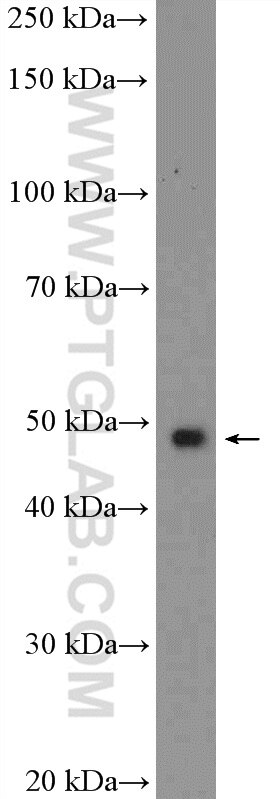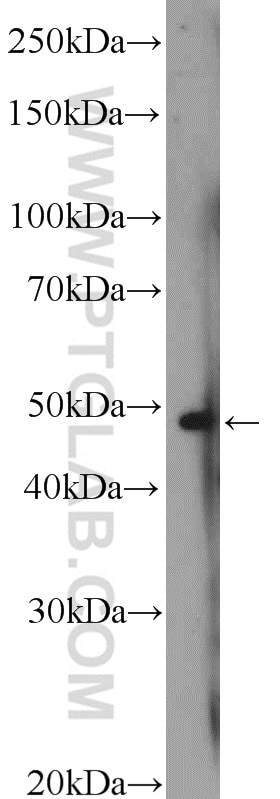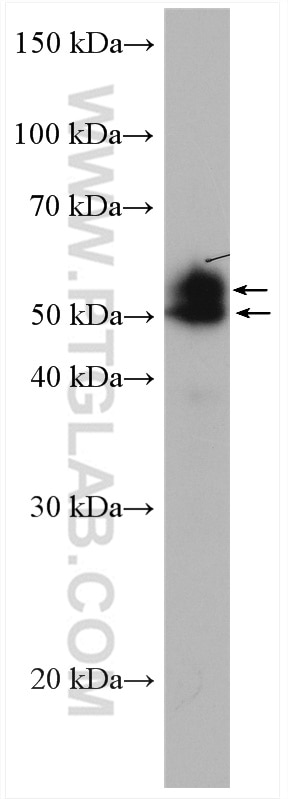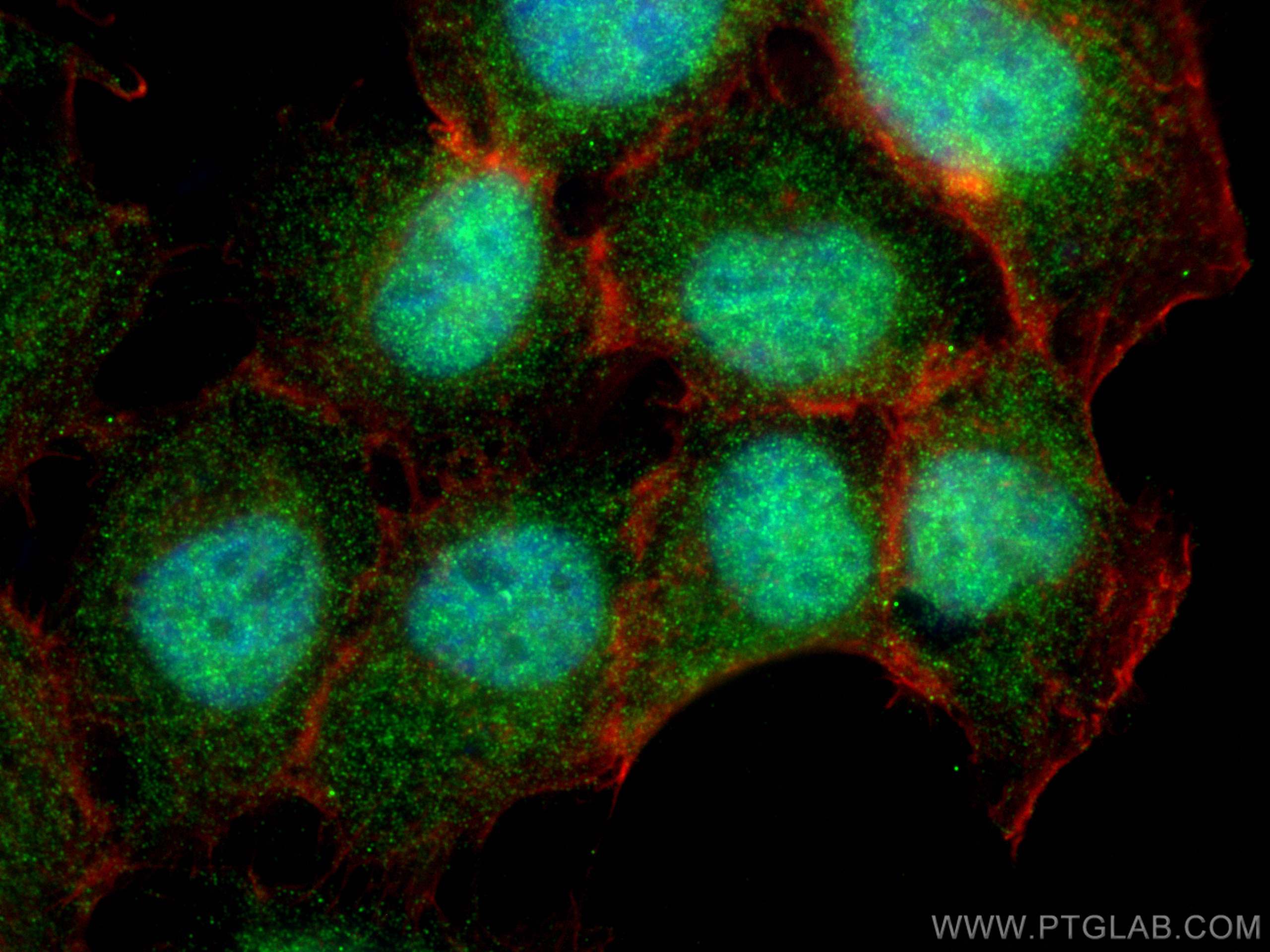Anticorps Polyclonal de lapin anti-MAZ
MAZ Polyclonal Antibody for WB, IF/ICC, ELISA
Hôte / Isotype
Lapin / IgG
Réactivité testée
Humain, souris
Applications
WB, IHC, IF/ICC, ChIP, ELISA
Conjugaison
Non conjugué
N° de cat : 21068-1-AP
Synonymes
Galerie de données de validation
Applications testées
| Résultats positifs en WB | cellules HeLa, tissu pulmonaire de souris |
| Résultats positifs en IF/ICC | cellules A431, |
Dilution recommandée
| Application | Dilution |
|---|---|
| Western Blot (WB) | WB : 1:500-1:1000 |
| Immunofluorescence (IF)/ICC | IF/ICC : 1:50-1:500 |
| It is recommended that this reagent should be titrated in each testing system to obtain optimal results. | |
| Sample-dependent, check data in validation data gallery | |
Applications publiées
| KD/KO | See 1 publications below |
| WB | See 5 publications below |
| IHC | See 1 publications below |
| IF | See 1 publications below |
| ChIP | See 1 publications below |
Informations sur le produit
21068-1-AP cible MAZ dans les applications de WB, IHC, IF/ICC, ChIP, ELISA et montre une réactivité avec des échantillons Humain, souris
| Réactivité | Humain, souris |
| Réactivité citée | Humain, souris |
| Hôte / Isotype | Lapin / IgG |
| Clonalité | Polyclonal |
| Type | Anticorps |
| Immunogène | MAZ Protéine recombinante Ag15200 |
| Nom complet | MYC-associated zinc finger protein (purine-binding transcription factor) |
| Masse moléculaire calculée | 477 aa, 49 kDa |
| Poids moléculaire observé | 49-55 kDa |
| Numéro d’acquisition GenBank | BC041629 |
| Symbole du gène | MAZ |
| Identification du gène (NCBI) | 4150 |
| Conjugaison | Non conjugué |
| Forme | Liquide |
| Méthode de purification | Purification par affinité contre l'antigène |
| Tampon de stockage | PBS with 0.02% sodium azide and 50% glycerol |
| Conditions de stockage | Stocker à -20°C. Stable pendant un an après l'expédition. L'aliquotage n'est pas nécessaire pour le stockage à -20oC Les 20ul contiennent 0,1% de BSA. |
Informations générales
Myc-associated zinc finger protein (MAZ) is a six zinc finger protein with a G-rich binding motif. MAZ is often found at genomic binding sites adjacent to CTCF, a protein which affects large-scale genome organization through its interaction with cohesin (PMID: 33558242). MAZ is widely expressed in most human tissues, such as heart, lung, brain, liver, placenta, testis, colon, peripheral blood leukocytes, skeletal muscle, thymus, pancreas, prostate, thyroid, and adrenal gland (PMID: 35098656). In cancer, MAZ has been proved to be highly expressed in malignant tumors, and to promote cancer progression and metastasis by regulating the transcription of downstream target genes through directly binding with target gene promoters or synergistic action with other transcription factors.
Protocole
| Product Specific Protocols | |
|---|---|
| WB protocol for MAZ antibody 21068-1-AP | Download protocol |
| IF protocol for MAZ antibody 21068-1-AP | Download protocol |
| Standard Protocols | |
|---|---|
| Click here to view our Standard Protocols |
Publications
| Species | Application | Title |
|---|---|---|
Oxid Med Cell Longev TUG1/MAZ/FTH1 Axis Attenuates the Antiglioma Effect of Dihydroartemisinin by Inhibiting Ferroptosis | ||
Genomics PLOD1 promote proliferation and migration with glycolysis via the Wnt/β-catenin pathway in THCA | ||
Alzheimers Res Ther Uncovering the epigenetic regulatory clues of PRRT1 in Alzheimer's disease: a strategy integrating multi-omics analysis with explainable machine learning | ||
Commun Biol Molecular mechanisms of MAZ targeting up-regulation of NDUFS3 expression to promote malignant progression in melanoma | ||
Oncogene YBX1 promotes 5-Fluorouracil resistance in gastric cancer via m5C-dependent ATG9A mRNA stabilization through autophagy
|





